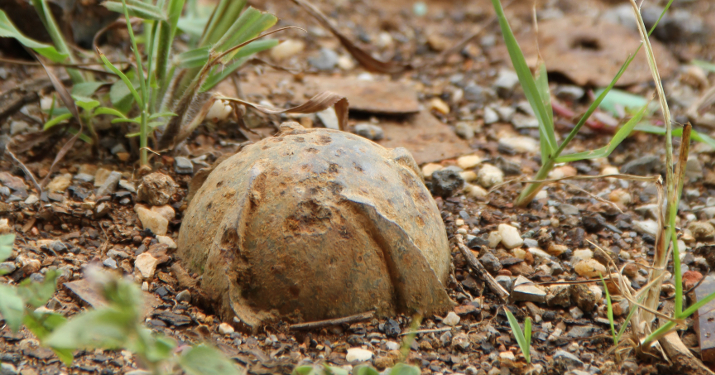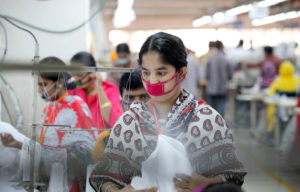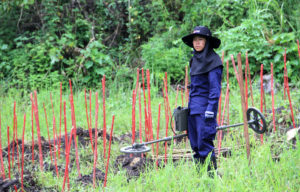
Cluster bomb in ground CCBY Mines Advisory Group
Countries are getting rid of cluster bombs
In just five years, 93 countries have destroyed nearly all of their cluster bombs, according to a newly published monitoring report.
Share
Banning the bombs
The Convention on Cluster Munitions is an international humanitarian agreement to ban the production, stockpiling, export, and use of cluster weapons. The treaty entered into force in 2010, and 117 countries have so far signed the treaty. Of these, 93 countries have ratified the treaty by implementing it in their national law.
Before the treaty, 91 countries had stockpiles of cluster munitions. At least 26 countries have now destroyed their entire stockpile, and a further 15 are currently in the process of doing so. Great Britain, Canada, and Japan are among the nations that have already completely rid themselves of their cluster weapons.
Several other countries are almost there. Germany previously owned more than half a million complete cluster munitions, but now only retains 587 weapons, which they use for training explosive ordnance disposal. Denmark declared in 2014 that all its complete cluster munitions had been destroyed, but the country keeps 3,634 bomblets for training and research purposes.
Other categories
Region: Global
Theme: Peace & security
In 2008, a group of countries agreed to ban cluster munitions, a type of weapon that scatters smaller ‘bomblets’ over a large area, causing widespread civilian suffering. The countries promised that they would stop using cluster weapons, stop producing them, destroy their existing stockpiles, clear their land of unexploded munitions, and provide assistance to civilians who have been maimed by the weapons.
Millions of bombs safely destroyed
These promises are now being put into action, according to a recently published five-year review report from the organisation International Cluster Munitions Monitor.
Since 2010, the countries participating in the Convention against Cluster Munitions have destroyed 1.3 million cluster weapons, containing a total of 160 million submunitions. This amounts to 90 percent of the stockpiles of the participating nations. A further seven countries had already destroyed their stockpiles before the treaty entered into force.
As well as scrapping their bombs, many countries are also making progress with clearing areas contaminated by old unexploded bomblets from previous conflicts. Since 2010, the countries of the world have cleared a total of 255 km2, and the majority of clearing operations are taking place in countries that have signed the treaty.
Success after tough decisions
Mary Wareham, Advocacy Director of Human Rights Watch, is pleased with the progress:
“It’s a great success that we managed to establish the treaty. All the participating countries are doing very well to destroy their stockpiles of cluster munitions – even far ahead of their deadline. But as long as these weapons continue to exist and cause casualties, we still have work to do”.
Human Rights Watch was one of the founders of the Cluster Munitions Coalition, and as a leading figure in HRW, Mary Wareham has been closely involved in the work to ban cluster bombs. She says it has not been easy:
“For some countries, it was a painful decision to give up cluster bombs, as they had spent a lot of money on their stockpiles, or were profiting from producing the bombs for export. But in the end, they came to the conclusion that the devastating humanitarian effects of the weapons simply outweigh their military usefulness”.
Indiscriminate destruction
When a cluster bomb drops, it’s not only dangerous for enemy troops on the ground. The bomb splits open in the air, to scatter hundreds of hand grenade-like bomblets over an area the size of a football field or even more. Some of the bomblets might hit the enemy, others risk hitting civilians in the area. In addition, individual bomblets often fail to explode on impact, and can stay hidden in grass or soil for many years. If someone later picks up or steps on a bomblet, it can then trigger the explosion, causing serious injury or death.
While cluster bombs are designed to attack enemy forces, statistics show that 92 percent of the victims are civilians, and that half of these are children. In spite of this, several countries have still not signed the treaty to ban the weapons. Among the non-signatories are USA, Russia, several Eastern European countries, China, India, Pakistan, and Brazil.
Growing opposition
But opposition seems to be rising globally against cluster weapons, even among countries that have not yet signed the ban. While the United States has not signed the treaty, the country has nevertheless declared that it has destroyed 221,502 tonnes of cluster munitions from its stockpile, and has plans to destroy further 250,224 tonnes before 2018. And more than 140 countries have condemned the use of cluster bombs in Syria.
“There’s now a lot of stigma attached to cluster bombs. Even countries that use them will often deny it, cover it up, or blame the other side in the conflict. Two UN resolutions have recently condemned use of these weapons, without USA or Russia vetoing them. This shows that there’s now a near worldwide opposition to using cluster weapons,” concludes Mary Wareham.
The problematic weapons have been used in several wars recently, including in Syria and Ukraine. However, none of the countries participating in the treaty have used them since 2010.







